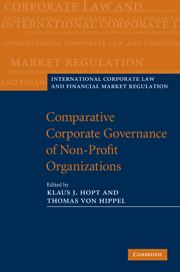Book contents
- Frontmatter
- Contents
- List of contributors
- Preface
- Abbreviations
- PART I Economic findings and theories on nonprofit organizations
- PART II The nonprofit sector: private law, trust law, tax law in selected countries
- PART III The board of nonprofit organizations
- PART IV Good governance of nonprofit organizations: activities and regulatory problems
- PART V Good governance of nonprofit organizations: self-regulation, disclosure and supervision
- 13 Self-regulation
- 14 Disclosure, reporting, auditing
- 15 Enforcement by state supervision and tax authorities
- 15.1 The Charity Commission for England and Wales
- 15.2 Internal Revenue Service and State Revenue Department oversight of nonprofit organizations in the United States
- 15.3 Tax law as an instrument to strengthen the corporate governance of the nonprofit sector
- Index
- References
15.2 - Internal Revenue Service and State Revenue Department oversight of nonprofit organizations in the United States
from 15 - Enforcement by state supervision and tax authorities
Published online by Cambridge University Press: 05 August 2011
- Frontmatter
- Contents
- List of contributors
- Preface
- Abbreviations
- PART I Economic findings and theories on nonprofit organizations
- PART II The nonprofit sector: private law, trust law, tax law in selected countries
- PART III The board of nonprofit organizations
- PART IV Good governance of nonprofit organizations: activities and regulatory problems
- PART V Good governance of nonprofit organizations: self-regulation, disclosure and supervision
- 13 Self-regulation
- 14 Disclosure, reporting, auditing
- 15 Enforcement by state supervision and tax authorities
- 15.1 The Charity Commission for England and Wales
- 15.2 Internal Revenue Service and State Revenue Department oversight of nonprofit organizations in the United States
- 15.3 Tax law as an instrument to strengthen the corporate governance of the nonprofit sector
- Index
- References
Summary
Background
Because the United States has a federal legal system, both the federal government and the individual states exercise independent taxing jurisdiction. The federal Internal Revenue Service (IRS) enforces federal income tax laws, while state departments of revenue enforce state income tax, property tax and sales tax laws.
In both cases, however, tax authorities exercise supervisory authority over nonprofit organizations only if those organizations seek tax exemption. In the United States, “nonprofit” is not synonymous with “tax-exempt.” “Nonprofit” is a state business organizations concept, and the word does not really mean what it implies. “Nonprofits” can and do have profits in the sense of net revenues after expenses; instead, the key factor in defining nonprofit status is what Henry Hansmann has termed the “nondistribution constraint” – that is, a nonprofit organization cannot have equity owners entitled to distributions of net revenues. Instead, any net profits must be reinvested in the nonprofit enterprise. One creates a nonprofit organization either by incorporating under state nonprofit corporation laws or by drafting a state-law charitable trust.
Nonprofit status is a necessary element to tax exemption, but it is not a sufficient element. Instead, tax exemption is controlled by federal and state tax law concepts which impose additional legal requirements. Because of the federal system, nonprofits often must deal with four different tax regimes administered by two different jurisdictions (federal and state): the federal income tax, the state income tax, the state property tax and the state sales/use tax.
- Type
- Chapter
- Information
- Comparative Corporate Governance of Non-Profit Organizations , pp. 914 - 939Publisher: Cambridge University PressPrint publication year: 2010



